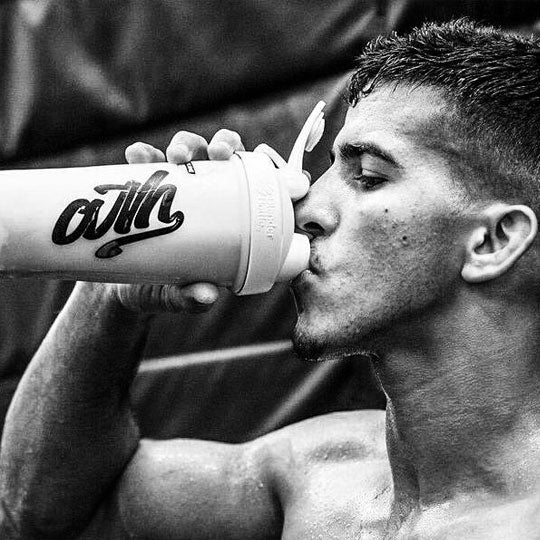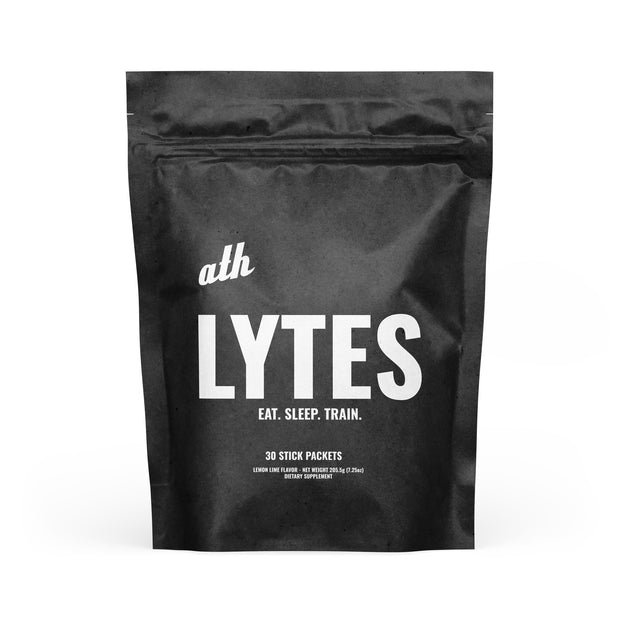Tips and Tricks on How to Replenish Electrolytes - Plus the Importance of It All

We all know the importance of proper hydration during an intense workout, but did you know you lose more than water when you sweat? Although sweat is primarily composed of water, it also contains electrolytes that are essential for your body to function correctly.
In fact, a water loss of just 2% of your body weight can lead to a fluid and electrolyte imbalance that can compromise your athletic performance and health.
In this article, we’ll discuss how to replenish electrolytes and everything you need to know about their function in your body.
WHAT ARE ELECTROLYTES AND WHY YOU NEED TO REPLENISH THEM…
Electrolytes are minerals found in your body that carry an electrical charge. They are typically found in the foods you eat and the fluids in your body.
These minerals keep your nerves, brain, muscles, and heart functioning normally. Electrolytes also work to regulate your body’s fluid balance and generate new tissue.
Intense exercise is one of the most common ways to lose electrolytes. The more you sweat, the more water and electrolytes are lost.

To properly hydrate after an intense workout and keep your body functioning smoothly, you must replete electrolytes along with water. This is because, without a proper electrolyte balance, your body cannot properly absorb and utilize the fluid you take in.
Though water is an excellent hydration option for low-intensity exercises, it only contains trace amounts of electrolytes. These amounts are insufficient to cover your needs after an intense workout.
The two main electrolytes your body loses through intense exercise are sodium and chloride. However, you’ll also lose small amounts of magnesium, potassium, and calcium.
Let’s take a look at the most common electrolytes and how they help your body function.
SODIUM
Sodium is one of the most abundant electrolytes lost in sweat. On average, you can lose around 1,000 mg of sodium in every liter of sweat, making it crucial to replete sodium after intense training sessions.
Most of us know the health risks of too much sodium, but low sodium levels in your body can also cause harm. Hyponatremia is one of the most common electrolyte disorders among athletes.
We need sodium for many different functions, including regulating muscle function, nerve function, and blood pressure control.
CHLORIDE
Chloride is another electrolyte lost in significant quantities when you sweat. It helps maintain your blood pressure, oxygen delivery, and acid-base balance. Chloride works together with sodium and potassium to maintain your fluid balance.
POTASSIUM
Potassium regulates your heartbeat, ensures proper muscle function, nerve function, and is needed to metabolize carbohydrates and synthesize protein. Potassium is mainly lost through your urine but is also lost in small quantities when you sweat.
MAGNESIUM
Magnesium plays a key role in over 300 enzyme systems required for nerve and muscle contraction, blood glucose control, energy production, and immune function. It also helps regulate your blood pressure and heart rhythm.
Although it’s not directly associated with hydration like sodium, chloride, and potassium, it still plays a vital role in overall health and hydration.
CALCIUM
Nearly 99% of calcium is stored in your bones. The remaining 1% circulates in your blood. Your body needs calcium for blood clotting, maintaining bone strength, muscle function, and nerve impulses.
If calcium levels in the blood are too low, it gets pulled from bone stores. Over time, this can lead to your bones becoming very weak. However, during exercise, the amount lost is very low.
HOW MUCH ELECTROLYTES DO YOU NEED?
Several factors come into play when deciding the amount of electrolytes your body needs. If you’re powering through intense workouts or experiencing excessive sweating in the heat, you’re likely going to need electrolyte beverages or sports drinks to maintain normal electrolyte levels.

Individual sweat rates can depend on the duration of your physical activity, the intensity of your workout, and environmental temperature.
As a general rule of thumb, here are the standard daily electrolyte needs for most adults:
- Sodium: 2,300 mg
- Chloride: 2,300 mg
- Potassium: 4,700 mg
- Magnesium: 420 mg for men, 320 mg for women
- Calcium: 1,000 mg
To assess your individual electrolyte needs, consider speaking with a sports dietitian.
COMMON SIGNS OF ELECTROLYTE IMBALANCE
One of the most common signs of an electrolyte imbalance is thirst, followed by muscle cramping related to low sodium levels. However, more severe symptoms are not uncommon, so it’s important to know what to look for.
Here are some other signs of an electrolyte imbalance:
- Headache
- Dizziness
- Fatigue
- Nausea
- Vomiting
- Frequent urination
- Irregular heartbeat
- Body aches
- Confusion
- Muscle weakness
- Lightheadedness
- Muscle contractions
- Muscle cramps
- Weakness
If you do not remain hydrated before, during, and after exercise, it can lead to many troubling symptoms like the ones mentioned above. While most people opt for replenishing their lost electrolytes by drinking sports beverages, many foods also replenish your electrolytes.
Let’s take a look at some natural foods that replenish your electrolyte stores.
FOODS THAT REPLENISH ELECTROLYTES

SODIUM RICH FOODS
- Salted nuts
- Smoked salmon
- Canned tuna
- Pretzels
- Salted whole-grain crackers
- Olives
POTASSIUM RICH FOODS
- Coconut water
- Bananas
- Apricots
- Prunes
- Artichoke
- Potatoes
- Orange juice
CHLORIDE RICH FOODS
- Olives
- Tomatoes
- Seaweed
- Lettuce
- Rye
MAGNESIUM RICH FOODS
- Spinach
- Pumpkin seeds
- Almonds
- Flaxseed
- Whole grains
- Dark chocolate
FREQUENTLY ASKED QUESTIONS
WHAT ARE SYMPTOMS OF ELECTROLYTE IMBALANCE?
The most common symptoms of electrolyte loss are feelings of thirst and muscle cramps from excess sodium loss.
If your electrolytes remain out of balance, you may experience dizziness, irregular heartbeat, lethargy, or fatigue. Severe electrolyte imbalances can result in a coma, seizures, cardiac arrest, and even death.
WHAT IS FLUID AND ELECTROLYTE BALANCE?
A fluid and electrolyte balance occurs when you have an adequate amount of electrolytes and fluid within your body to carry out its normal functions. To remain in balance, your fluid intake should be equal to the fluid you lose.
HOW LONG DOES IT TAKE TO REPLENISH YOUR ELECTROLYTES
For a mild electrolyte abnormality, you can expect to feel better within 2-3 hours of replenishing electrolytes with sports drinks or electrolyte drinks. However, if your dehydration is severe, it could take days in a hospital.
HOW DO YOU GET YOUR ELECTROLYTES BACK UP?
If you’re experiencing symptoms of mild dehydration, you can replenish your electrolytes with high-quality sports drinks, coconut water, electrolyte-infused waters, or diet modifications.
For severe dehydration, you may require a hospital stay with intravenous electrolyte replacement.
SHOULD I TAKE ELECTROLYTE SPORTS DRINKS?
Yes, if you’re excessively sweating or working out longer than 45 minutes to one hour, you should consider drinking an electrolyte sports beverage. However, you should choose a high-quality sports drink that is free of artificial sugar and additives to prevent doing more harm than good.

Our LYTES combines sodium, chloride, potassium, and magnesium in a delicious lemon-lime flavor to support endurance, delay fatigue, and regulate muscle contractions. Not only is it free of artificial ingredients, but it also has zero carbs, zero sugar and is gluten-free.
BOTTOM LINE
Electrolytes are essential for our body to perform at its peak. High-intensity exercise puts you at risk for an electrolyte imbalance. This can hinder your athletic performance and result in severe health consequences.
While minerals like sodium and chloride are lost in the sweat in larger quantities, paying attention to other minerals like potassium and magnesium is essential.
To avoid an electrolyte imbalance messing with your workout routine and fitness goals, you should make it a priority to replenish electrolytes.
While electrolyte-rich foods are certainly a great option to naturally replenish electrolyte levels, it can be challenging to have these items readily available.
Sports drinks are a great, convenient option to replenish electrolytes after an intense training session. However, when replenishing lost electrolytes with electrolyte beverages, it’s vital to choose beverages free of artificial ingredients and sugar to prevent doing more harm than good.



